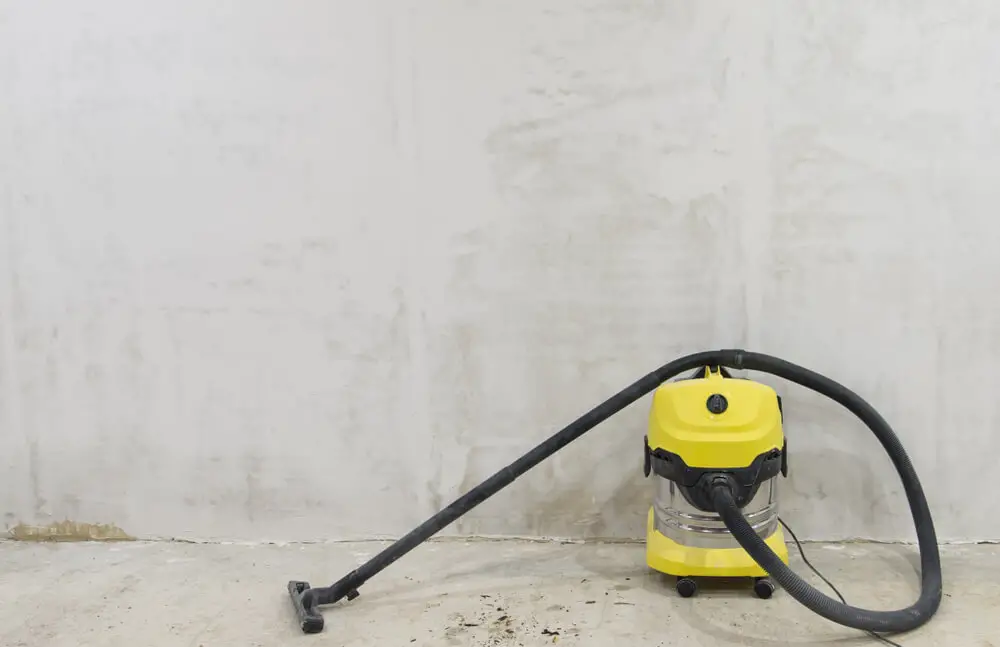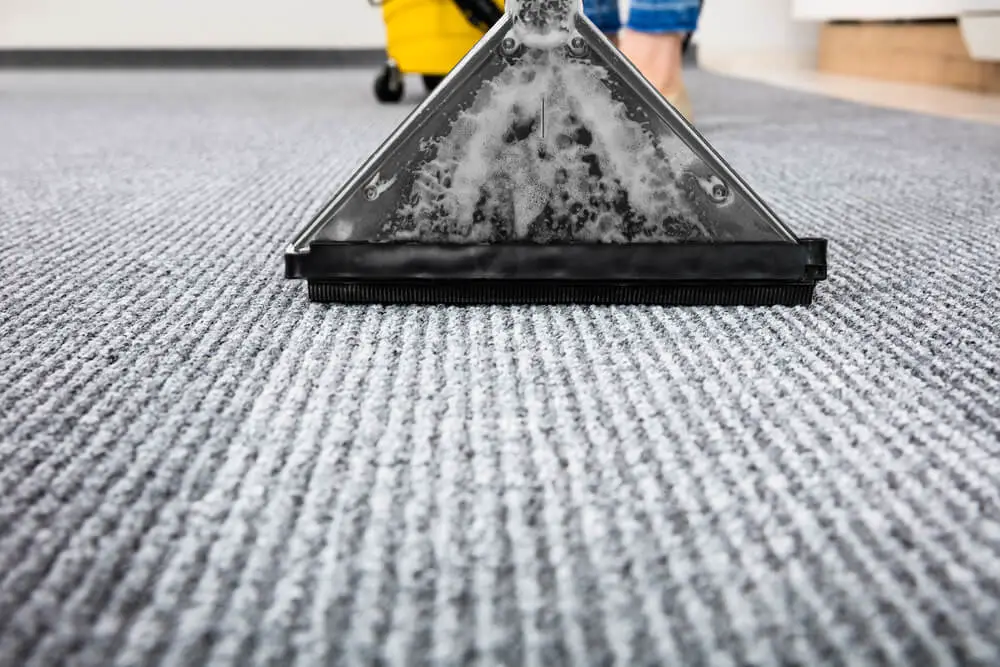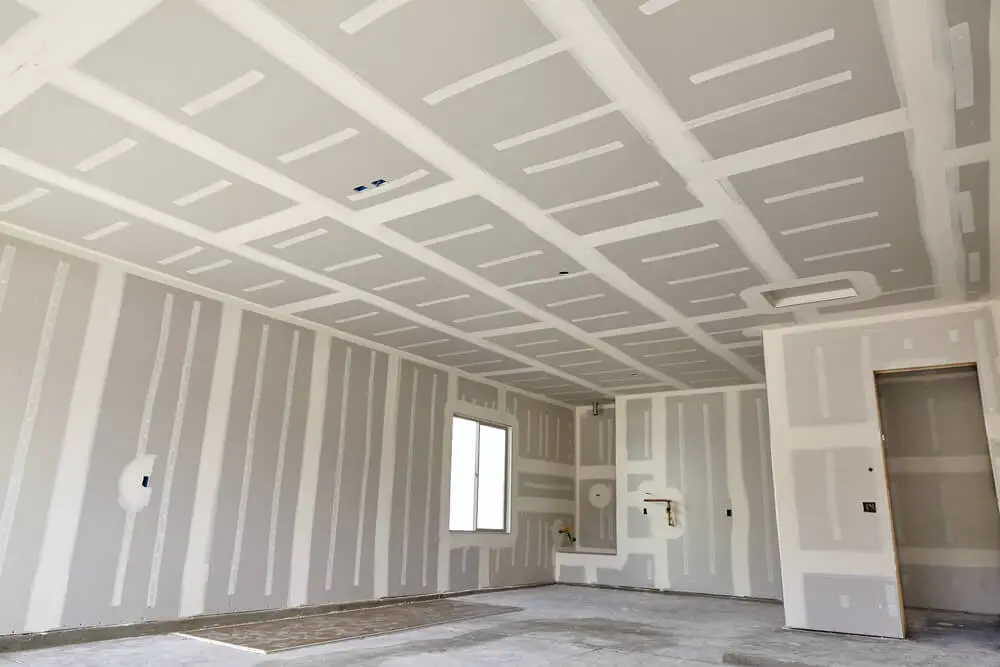Installing drywall is a quick and convenient way to create a more usable space in your home. Yet, issues can arise when sanding or cutting drywall sheets during a remodel.
Usually, this remodel project brings with it clouds of drywall dust, which is often very fine. The dust harbors many substances, including silica, gypsum, and mica.
These substances not only cause discomfort but also create a respiratory hazard. Left unattended, they can settle in every nook and cranny of your room, making a horrible mess.
For these reasons, it's in your best interest to contain the drywall dust and turn your room into a livable space. So, how do you clean up drywall dust? Read on to learn more about some proactive measures to clean up drywall dust the right way.
Is It Okay To Vacuum Drywall Dust?

Sure, a vacuum cleaner can help you remove drywall dust from your floors and surfaces. Whether it's the doors, windows, or carpets— a vacuum cleaner will do the trick.
But then again, it's best to ask yourself which type of vacuum cleaner is best for drywall dust cleanup. To clean up drywall dust, you need a good shop vac with a brush attachment. A regular household vacuum cleaner – especially one without a HEPA filter— won't cut it.
If you must use your regular vacuum cleaner to clean up drywall dust, be sure to attach a heavy-duty HEPA filter. That's the only way you'll be able to remove the drywall compound without a shop vac.
Best Way To Vacuum Drywall Dust

First, you want to be sure you're prepared for the job ahead of you. As you know, drywall dust particles are very tiny and easy to inhale. When they fill up the air in your room, they can result in respiratory ailments.
You better be safe than sorry, right? To avoid inhaling the poisonous drywall dust, invest in a dust mask. A good mask is capable of preventing you from inhaling fine drywall dust.
As mentioned earlier, drywall dust boasts an array of hazardous substances. Those substances may irritate parts of your body,including the eyes and throat. Wearing a dust mask will keep you safe throughout the cleaning project.
A Step-By-Step Guide for Vacuuming Fine Dust

Step #1 Increase the Ventilation
Before you start to clean drywall dust, make sure your house is well ventilated. Open the doors and windows to your house. Also, switch off the heating, ventilation, and air conditioning system.
If plastic sheeting is within your reach, use it to cover all the vents in your house. This is done so that there is the least amount of drywall particles circulating in the house as you clean.
Step #2 Direct the Drywall Dust Outside
Place a fan at the window and make sure it's facing outside. If you have multiple windows, it's recommended you put a fan in each one.
But if there are few fans at hand, don't worry. Keep all the windows open to create a cross-draft that'll help maximize fresh air in your rooms and floors.
When you place a fan at the window and set it to face the outside, you restrict air circulation. This is a great way to prevent drywall dust from spreading into the air.
By using a fan, you can also help direct the drywall dust in the room to the outside. The dust won't be able to re-circulate back into your room's air when vacuum cleaning.
Step #3 Sweep the Bulk of the Drywall Dust
Armed with a broom, sweep the walls and floor surfaces to remove most of the drywall dust. Then collect it into a pile and then transfer it into a dust bag by using a dustpan. Go over the surface a few times 'till most of the drywall dirt is gone.
After getting rid of the drywall dust, allow about 15 minutes for the fine airborne dust to settle. If in a hurry to clean, spray a water mist onto the dust to make it settle faster. Then proceed to the next
step.
Step #4 Vacuum Floors and Surfaces
Soon after the bulk of the dust has vanished, start vacuuming your floors and surfaces. For this, a good shop vac with a brush attachment will do the trick.
With the attachment, you can remove dust from corners and in-between hardwood floorboards. Make sure to vacuum your floors and surfaces from top to bottom and left to right.
Move gradually so the suction can pull out drywall dust that may be clinging onto walls. If you sprayed the water mist onto the dust, you better use a stronger wet-dry shop vacuum. This will help remove drywall dust without clogging the filters.
Step#5 Clean With a Damp Cloth
After vacuuming all the surfaces in your house, the final step is to wipe them down. You can decide to use either a damp cloth or a wet microfiber mop to rid the dust residue.
But the cloth is preferable because it quickly picks up whatever is left. The type of floor you have will determine whether to use a damp cloth or a wet mop.
For instance, a dry, absorbent microfiber cloth provides a great way to clean a laminate floor. But a regular wet mop may only be able to remove drywall dust residue off wood floors.
Start by wiping down the walls using a damp cloth. Next, spray all the surfaces with water while being careful not to use too much water. In the final step, gently sweep the misted dust into a dustpan or suck it up using a wet-dry shop vacuum.
How To Clean Drywall Dust Off Laminate Floors

Sweep the Excess Drywall Dust
If the sheetrock dust is too much, you may need to sweep the excess into manageable piles. Wear a face mask and use a soft and nonabrasive broom to clean the laminate.
Also, pick up too large particles using a dustpan. The idea here is to remain with finer dust thatScrape Off Any Stubborn Spots
Spritz some water over the dirty spots and scrub the floor with a sponge. If there are any more stubborn drywall dust spots, add more water to those spots and repeat the process.
Be careful when adding water because wet drywall dust can turn into a paste that leaves a film. All you need to do is pump a little water to dampen the drywall dust before sweeping slightly.
That way, the water won't create mud. It'll simply allow the drywall dust to clump together slightly, making it easier to sweep. Now, put on a good dust mask and start sweeping the area properly, beginning with the walls.
Vacuum the Area With a Shop Vac
You'll need a good shop vac with a brush attachment to blast drywall dust off laminate floors. I can't emphasize this enough—drywall dust can burn up a regular vacuum cleaner.
For this reason, always use a drywall shop vac and take advantage of its special filters. A shop vac features heavy-duty filters designed to deal with big chunky things pretty well. Furthermore, their motors won't get frazzled even if length they're left running for long.
Before vacuuming, make sure you pack away everything you don't need and cover it in plastic. Also, cover the doors and windows with tarps. It may seem to be overkill, but the last thing you want is to have drywall dust spread throughout the house.
We'd even suggest using a box fan and disposable furnace filter to limit airborne drywall dust. It's incredible how much dust this combo can take out of the air quickly.
Don't use a fine dust filter, though. A fine dust filter won't let the air through fast enough. Thus, use the coarse filters instead of the fine ones.
Mop the Area With Lukewarm Water
Immediately after vacuuming your concrete surface, mop the area thoroughly. Use a damp cloth and lukewarm water for this project.
This is to help lift off any drywall compound left on the concrete. Keep wringing the mop as you vacuum the area to rid any puddles of water.
You can also wipe the area with a clean, slightly damp rug to ensure no pool of water is sitting on laminate flooring. Please don't step on the concrete before it's dried. Give it at least 30 minutes to dry before stepping on it again.
Best Way To Clean Drywall Dust Off Furniture

Remove the Loose Debris
Remove any loose debris from the furniture using the broom head or brush. If possible, take upholstered furniture outside and set up a fan to blow through it.
Know that it's best to remove the cushions before leaning drywall dust off the furniture. If that's not possible, don't worry. You can still use a vacuum cleaning attachment to get all the dirt out of the crevices.
Once you're done, run a damp cloth over the surface of the furniture to pick up any lingering drywall dust.
Prepare the Cleaning Solution
Pour lukewarm water into the bucket, and then add a few drops of mild dish detergent. You're advised to do a spot test first to determine if the product is safe to use on your leather sofa.
And be sure to add just enough dish detergent to make bubbles. Keep in mind that the goal is to remove the drywall dust without leaving a soapy film behind.
Wipe Away the Drywall Dust
Dip a soft clean cloth into the water and detergent mixture, then squeeze it to rid the excess solution. You shouldn't let the cloth drip. Remember that too much moisture can ruin leather-upholstered furniture.
Using a slightly damp cloth, wipe away any drywall dust off the furniture. Rinse it out in the bucket and repeat the process as necessary.
Once the furniture looks clean, dab it with a clean, dry cloth to remove any remaining moisture.
Best Way To Get Drywall Dust Out Of Carpet

Dampen the Carpet With Clean Water
Cleaning drywall dust in carpet can be very difficult once the fibers absorb it. If sheetrock dust finds its way deep into carpeting, spray a little water over the area.
It would help if you aimed to moist the carpet without overdoing it. This will allow the drywall compound to coagulate, making it easier to pull off.
Scrape Off Caked-On Drywall Dust
Even ground-in dust can be removed with some elbow grease and patience. An excellent method to remove stuck-on drywall dust is to use a spatula, butter knife, or any tool with an edged surface.
That being said, move the spatula in a to-and-fro motion to loosen the compound and lift it right off the carpet. Avoid rubbing the carpet as this could push the compound further, making a bigger muddy mess.
Run a Vacuum Cleaner Over the Carpet
When dealing with drywall dust, your best bet is to use a vacuum. If you don't have one, you can easily rent it from a home improvement store. Fine drywall dust can ruin the motor of the average vacuum, so it's best to use a wet-dry shop vac.
Also, get one that uses a freestanding filter and preferable one that you can clean and reuse. This makes it very convenient to hose off your filter away from any drains that could lead to clogging.
Finish Off with a Carpet Cleaning Machine
After cleaning the drywall dust with a vacuum, grab your carpet cleaning machine. The portable carpet steam cleaner has revolutionized the carpet cleaning industry for decades.
When you use this device in your final cleaning step, you're sure to get spotless results. If you do it right, you can remove excess filth from carpets without a cinch.
You'll need to run a steam cleaner in small sections over your carpet. Also, pull it back and forth slowly to ensure it can have adequate time to suck and rid fine mud.
It would be helpful to use some good carpet cleaning solutions in the steam cleaning machine. That way, you can pull as much drywall dust as possible out of the carpet.
If you want to do the wet cleaning in the final step, then make sure you've lifted off all the dust from the carpet. Again, make sure to use an appliance that's strong enough to suck up to the last dirt.
If you're sure the carpet is clean enough, let it dry completely before using the room. This could take up to 24 hours, so patience is key.
Wrap Up
As a reiteration, sanding creates a fine, white dust that could easily cloud the whole house. The dust contains hazardous substances like silica, which can result in silicosis.
As the old saying goes: an ounce of prevention is better than a pound of cure. That means it's essential to perform drywall cleaning soon after sanding to rid the house of the dust.
By using the shop vac, you can clean up drywall dust quickly and effectively. And one last thing; always use canvas or paper drop cloths to cover your room. That'll prevent dust from entering the room, saving you the tedious cleaning job in the future.

